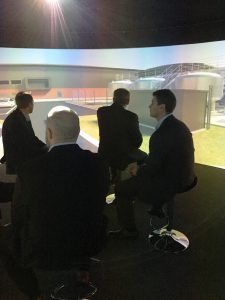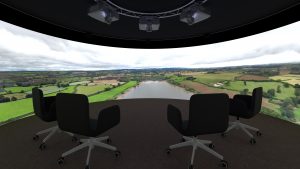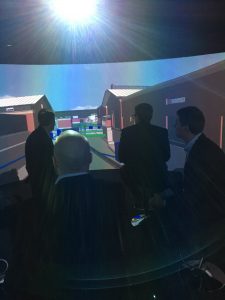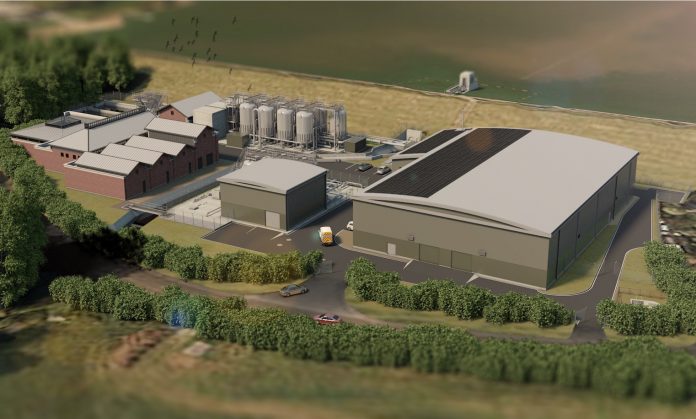Wessex Water and AECOM used Shared VR to improve teamwork and save costs, working on a £50m project to reconstruct the Durleigh Water Treatment Centre in the UK
The scheme would be Wessex Water’s first delivered to BIM Level 2, with the aim to use digital technology to work faster, safer and more efficiently. Realising the potential of an immersive collaborative environment, AECOM suggested the use of an Igloo Shared VR cylinder.
Wessex Water provides water and/or sewerage services to more than 2.8m customers in the south-west of England.
Its purpose is to:
- Provide its customers and communities with excellent service and value for money.
- Protect and improve the environment.
- Provide its employees with the opportunity for personal development and a satisfying career.
It supplies 275m litres of water a day, maintains and renews 7,442 miles of water mains, and fixes more than 1,000 leaks every month. It also takes away and treats 863m litres of sewage a day and looks after 21,637 miles of sewers.
The situation
 As its flagship scheme (and an important part of its current asset management plan), Wessex Water had planned a major upgrade of the Durleigh Water Treatment Centre. This would see significant benefits by:
As its flagship scheme (and an important part of its current asset management plan), Wessex Water had planned a major upgrade of the Durleigh Water Treatment Centre. This would see significant benefits by:
- Enabling it to consistently and safely deliver 30m litres a day
- Upgrading the condition and design of the ageing plant
- Addressing concerns over deteriorating raw water quality and the presence of pesticides and manganese
The plan entailed demolishing all the existing structures at the north end of the site. This would remove an admin building, a dissolved air flotation (DAF) plant and sand filters. This would be replaced with:
- A new main treatment building with processes for DAF and Rapid Gravity Filters.
- Manganese filters.
- A new low-lift pumping station.
The project was highly complex and technically challenging.
Wessex Water appointed AECOM as one of the six Tier 1 Design Capital Delivery partners to undertake the detailed design of the civil engineering and mechanical and industrial engineering (M&IE) works. This would be together with integrating the design elements undertaken by others.

The scheme presented new challenges:
- Wessex Water’s project to reconstruct Durleigh was the company’s first scheme to be delivered to BIM Level 2. That means the use of collaborative 3D models with embedded digital versions of all project and asset information, documentation and data. This was necessary due to the complexity of the site, where there were numerous existing underground services to be modelled. Furthermore, with the plant providing drinking water for 40,000 people in Somerset, it was crucial it be of the highest quality possible.
- As a private sector, the water industry had not needed to comply with the government’s April 2016 mandate that all public projects be procured and delivered using BIM Level 2 as a minimum requirement. There is a cultural change needed in the industry as a whole, where traditionally many engineers want to use and mark-up paper drawings.
The solution
Wessex Water worked with AECOM to introduce a digital strategy to bring a range of technologies and innovations to form a comprehensive digital engineering approach to the scheme and wider business.
These included:
- Creating a single source of information. A Common Data Environment stored all design information in the cloud, instead of a local server. This enabled high levels of collaboration across the supply chain, from project management to engineering, procurement to operations.
- A digital model that fully integrates all civil, mechanical, electrical and process design. Ground-penetrating data, laser scan data and drone surveys were used to create a highly accurate model of the new plant design. The use of drones also eliminated hazards associated with working on a fragile roof.
- Digital design reviews. Visualising the scheme in 3D allowed the delivery team to quickly understand the look and function of the proposed construction works, which would enable prompt on-site decision making.
- Design for Manufacture and Assembly (DfMA). By maximising opportunities for offsite prefabrication of components, efficiency could be increased. This reduced risks and helped deliver the scheme to deadline targets.
As part of this strategy, AECOM saw the potential for the use of an immersive, collaborative environment. AECOM suggested the use of an Igloo Shared VR system to Wessex Water, and a 6.5m cylinder was purchased. This would come to fulfil a crucial role in the design of the refurbishment.
The attraction of Shared VR
 Wessex Water had initially suggested implementing some form of AR or VR to aid design. AECOM trialled mixed-reality smart glasses, but struggled from a logistical perspective in visualising models. Wessex Water was also concerned that headsets would not be well received by stakeholders.
Wessex Water had initially suggested implementing some form of AR or VR to aid design. AECOM trialled mixed-reality smart glasses, but struggled from a logistical perspective in visualising models. Wessex Water was also concerned that headsets would not be well received by stakeholders.
An Igloo Shared VR system looked an ideal solution:
Sharing the experience
Wessex Water wanted the benefits of VR, such as being able to visualise a model instead of having to pore over detailed 2D drawings, while retaining the benefits of the team dynamic. With an Igloo Shared VR system, this allowed them to:
- Work collaboratively – everyone could see what everyone else was looking at.
- Brief team members – people could easily talk through what immersive content was being displayed.
- Communicate effectively – team members could gauge reactions by being able to make eye contact, read facial expressions and body language.
- Facilitate group discussions and arrive at a consensus opinion.
- It also saw appliance in engaging subcontractors.
Promoting understanding
In the past, the only way to share the plans for a new model was by looking over the complicated 2D drawings. With Shared VR, you can showcase and visualise a 3D model in an immersive environment where people can even walk around the virtual model. This can also identify DfMA opportunities by providing equipment suppliers an immediate understanding of the project.
Facilitating sessions for large numbers of participants
AECOM and Wessex Water wanted to cater for a group size of 12 people. It was able to specify a 6.5m diameter Shared VR cylinder with 360° projection and surround sound.
Future applications
Wessex Water could see an easy opportunity to utilise Shared VR beyond the project.
For example:
- Demonstrating the project for stakeholder buy-in.
- Possibilities for training.
- Uses on future projects needing to produce BIM models.
AECOM and Wessex Water held a joint proposal, discussion and decision on Igloo Shared VR Systems which were well received. It was felt being able to gauge reactions and keep eye contact while having a discussion was so crucial to how a team worked effectively.
AECOM created a 3D BIM model with data from ground-penetrating radar, laser scans and drone surveys. This 3D model was then combined with Revizto software to create a VR model.
An Igloo Shared VR system was assembled inside a disused building on the site. The size enabled up to 12 team members at any time to walk around the VR model of the site and carry out design reviews.
To make changes, laptops installed with Autodesk Revit and AutoCAD Plant 3D software would update the BIM models. Changes were pushed via the cloud to Revizto visual collaboration software. This could then be synced to the local Igloo server for viewing in a complete 360° immersive environment.
To navigate the VR environment, team members could use a simple Xbox controller.
The VR model also enabled the production of offsite components by providing information for equipment suppliers. 3D supplier fabrication details were inputted into the model. This would ensure the integration of the components into the site construction when delivered ready-made.
Highlights
The use of Shared VR on the project helped eliminate more than 100 structure clashes during the design process through automated clash detection.
Potential savings of £300,000 by using visualisation to rationalise layouts in the waste water treatment and low-lift pumping station.
With the use of Shared VR, AECOM also noted:
- Improved engagement and design coordination.
- Increased buy-in from stakeholders and colleagues.
- Improved plant construction and operability reviews.
- More efficient working, significantly saving time and costs.
Igloo Vision
+44(0)1588 673 337














